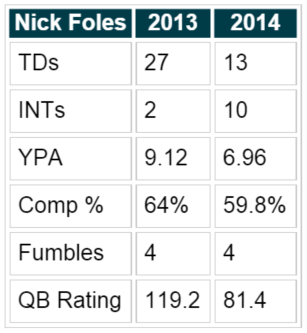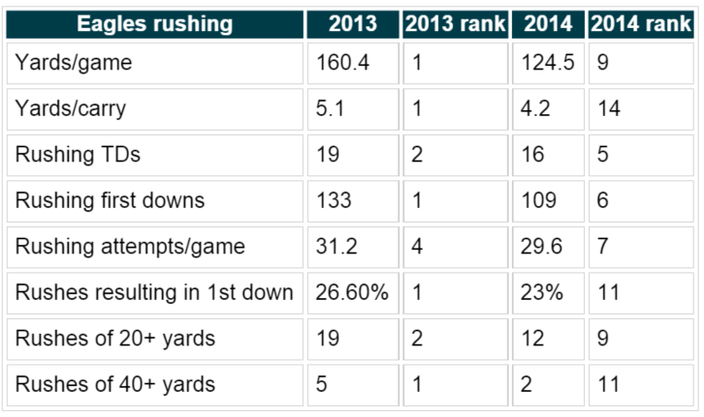
January 14, 2015
In 2013, as we all know, Nick Foles threw 27 touchdown passes and 2 interceptions. During the offseason last year, no reasonable Eagles fan expected Foles to come anywhere close to matching those numbers. However, that didn't necessarily mean that he couldn't improve as a player, even if those numbers would be nearly impossible to match.
But Foles did not get better. Instead, he regressed.
There were certainly a number of reasons why Foles was not set up to succeed the same way he did in 2013, which we'll list here:
No continuity along the OL: In 2013, the Eagles' offensive line stayed remarkably healthy. Its five starters - Jason Peters, Evan Mathis, Jason Kelce, Todd Herremans, and Lane Johnson - played a combined 98.18% of the offensive snaps. In 2014, those five players combined to play in just 68.62% of the team's snaps, and they were never once on the field at the same time. The lack of OL continuity understandably may have led to trust issues for Foles playing behind a makeshift offensive line.
Far less effective running game: In 2013, the Eagles running game was by far the best in the NFL. In 2014, behind the aforementioned banged up OL, it was nowhere near as potent:
When you have the best rushing attack in the NFL, that makes it much easier on the quarterback to be effective. Without the elite run game, Foles did not have the same enormous advantage that he enjoyed in 2013.
Teams around the league adapting to Chip Kelly's fast-paced offense: Chip Kelly's offense, from an X's and O's standpoint, is actually very basic. There was no mystery about what the Eagles offense wanted to do from the opposing defense's perspective. The biggest reason that Kelly's offense is so effective is speed and execution. With so many teams around the league trying to be up-tempo, a theory exists that defenses became more used to preparing for it. If there is validity to that theory, then certainly Foles would have the advantage of teams not knowing how to prepare for the Eagles' offense as well in 2013 as they did in 2014.
New QB coach: 2013 QB coach Bill Lazor left the Eagles to go be the Miami Dolphins' offensive coordinator last offseason. It is nearly impossible to quantify how much Lazor's absence affected Foles' play, but it is something that many fans have pointed out as a difference between the 2013 and 2014 seasons.
While many of the above excuses are valid, aspects of Foles' game clearly fell off. There were several differences in Foles game in 2014 than in 2013:
Deep ball accuracy: In 2013, Foles had tremendous success when he threw the ball more than 20 yards (Stats via ESPN). In 2014, not so much.
Of course, it doesn't help when you lose arguably the best deep threat in the NFL, but Foles' deep throws were often wildly off target. And Foles' inaccuracy wasn't exclusive to deep throws. His overall completion percentage dipped by 4.2%.
Pocket awareness: In the past, pocket awareness was a strength of Foles'. While everyone knows that he's not exactly Usain Bolt, Foles did a good job both in 2012 and 2013 of feeling pressure, sliding away from it and throwing on the run. In 2014, he retreated backward far too often instead of stepping up into the pocket or escaping the pocket laterally. This led both to bad decisions and unnecessary sacks.
Back foot throws: Foles' back foot throws were somewhat of a continuation of his poor pocket awareness. Often, when he would retreat a la Kevin Kolb, he would make inaccurate back foot throws with no juice that rarely connected.
Not seeing open receivers: This was a problem both with Foles and Mark Sanchez. In watching All-22 film after each game, there always seemed to be numerous wide open receiving targets that Foles and Sanchez simply didn't see, or didn't trust. In 2013, Foles seemed to see the field much better.
When Foles was injured in the Eagles' eighth game against the Texans, many fans were almost eager to see what "the other guy" could do, as Foles had not been as effective as expected. Sanchez proved not to be a savior, and in my opinion, was not as effective as Foles. Sanchez was good in games the defense played well and the run game was working, such as the first game against the Cowboys, and the Panthers game. Otherwise, he was prone to turnovers when he asked to make plays, much like his career with the Jets.
While he was certainly nowhere near as good in 2014 as he was in 2013, Foles' injury was more of an impact to the demise of the 2014 Eagles than is typically noted.
Follow Jimmy on Twitter: @JimmyKempski


